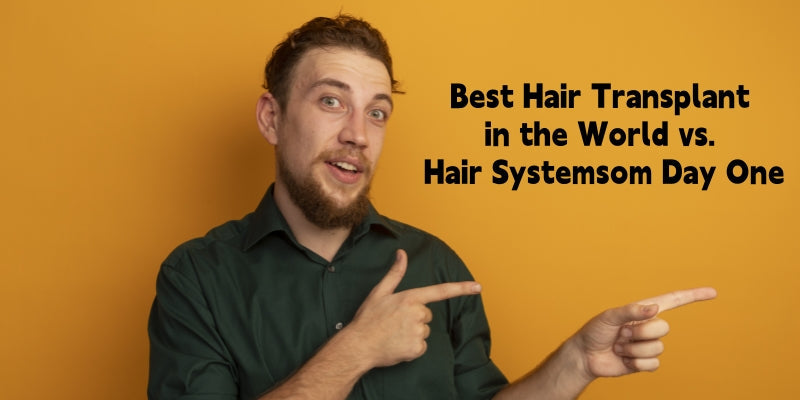
Best Hair Transplant in the World? Or the Hair System That Looks Perfect from Day One
Best Hair Transplant in the World? Or the Hair System That Looks Perfect from Day One
Every year, thousands travel abroad searching for the best hair transplant in the world. They scour forums, read clinic reviews, and compare surgeon portfolios from Turkey, South Korea, Spain, and the United States. But what if the “perfect” hairline you’re chasing could be achieved instantly — without surgery, without waiting a year, and at a fraction of the cost?
In this article, we compare the world’s top hair transplant methods with modern hair systems, exposing the pros, cons, and the surprising reality that’s turning more people away from surgery.
What Defines the “Best” Hair Transplant?
Determining the “best” hair transplant involves several factors:
- Naturalness of the result — hairline design, density, and direction.
- Longevity — transplanted hair should last for decades.
- Minimal scarring — especially for patients who wear short hairstyles.
- Recovery time — how quickly you can return to normal activities.
- Surgeon skill — experience and artistic ability in hairline creation.
Even with all these elements optimized, surgery still has limitations, especially for those with advanced hair loss or poor donor supply.
Top Hair Transplant Clinics Around the World
Based on patient reviews, forum discussions, and awards, these clinics often appear on “best in the world” lists:
- Dr. Koray Erdogan – ASMED, Turkey (FUE specialist)
- Dr. Lorenzo – Spain (impeccable density work)
- Dr. Bisanga – Belgium (high success with repair cases)
- Dr. Wong & Dr. Hasson – Canada (mega-session FUT experts)
- Dr. Cooley – USA (FUT + PRP combination approaches)
But even patients at these elite clinics face the same unavoidable truths: healing time, cost, and the risk of an imperfect result.
The Hidden Limitations of Surgery
Hair transplants are permanent — but that doesn’t always mean “perfect forever.” Hair loss is progressive, meaning native hair can continue thinning even after surgery. This often requires multiple procedures over the years.
Common frustrations include:
- Shock loss in surrounding native hair.
- Insufficient density, especially in the crown.
- Visible scarring under certain lighting or hairstyles.
- High cumulative costs from multiple sessions.
The Hair System Advantage
Modern hair systems, especially ultra thin skin bases, bypass these limitations entirely. Here’s why:
- Instant coverage — walk in bald, walk out with a full, natural head of hair.
- Perfect density — every strand placed exactly where it needs to be.
- Zero donor limitations — works for complete baldness.
- Customizable style — change hairlines, lengths, and colors without commitment.
Instead of waiting months for transplanted grafts to grow, hair systems deliver a flawless look immediately.
Day-One Perfection vs. 12-Month Wait
After a hair transplant, patients often experience 2–4 weeks of visible redness, scabbing, and swelling. Then, the transplanted hair sheds, leading to the infamous “ugly duckling” phase. Only after 8–12 months do you see the final result — and even then, density may not meet expectations.
With hair systems, you skip all that. The day you get your system fitted is the day you look photo-ready. This is why more professionals, actors, and athletes quietly choose hair systems over surgery.
Global Cost Comparison
| Country | Hair Transplant Cost | Hair System Cost |
|---|---|---|
| Turkey | $2,000–$6,000 | $400–$1,000 |
| USA | $8,000–$20,000 | $500–$1,200 |
| UK | £6,000–£15,000 | £350–£900 |
| Spain | €4,000–€12,000 | €350–€800 |
Even the “affordable” surgery destinations cost more than a full year of premium hair system wear — without factoring in time off work or travel expenses.
Lifestyle Flexibility
Hair systems adapt to your lifestyle. Need a buzz cut look for summer? Done. Want a longer style for winter? Also done. Hair transplants lock you into the limitations of your donor hair, while systems give you complete creative freedom.
They’re also ideal for people whose work or hobbies involve public appearances — you can always present your best self without waiting for hair to grow.
Global Success Stories
From London bankers to New York actors, real-world transformations show why hair systems are overtaking transplants:
Case 1: A 36-year-old finance executive in Singapore switched from two failed FUE surgeries to a custom ultra thin skin system. He went from wearing hats daily to confidently speaking at conferences without fear of lighting exposing thinning spots.
Case 2: A 29-year-old Australian surfer feared hair systems would peel during water sports. After testing waterproof adhesives, he reported zero issues even during week-long surf trips.
Case 3: A 42-year-old Italian chef found surgery downtime impossible due to his busy restaurant schedule. A hair system gave him instant coverage without taking time off work.
Hair System Maintenance Guide
- Clean the scalp thoroughly before each application.
- Use a breathable cap or ultra thin skin for natural feel.
- Schedule re-bonds every 3–4 weeks for optimal appearance.
- Rotate between two systems to extend lifespan.
Conclusion
While the best hair transplant in the world can deliver great results for the right candidates, modern hair systems offer a more flexible, cost-effective, and instant solution — especially for those who can’t afford the risk or downtime of surgery. For many, the question is no longer “Where should I get my transplant?” but “Why would I get surgery at all?”
FAQ
Q: Can hair systems really look as natural as a transplant?
A: Yes. With today’s ultra thin skin bases and hand-tied hairlines, they’re virtually undetectable.
Q: Are hair systems permanent?
A: They require periodic replacement, but offer consistent results without surgical risks.
Q: Do hair systems work for women?
A: Absolutely — they can be customized for any gender, hair type, or density.








